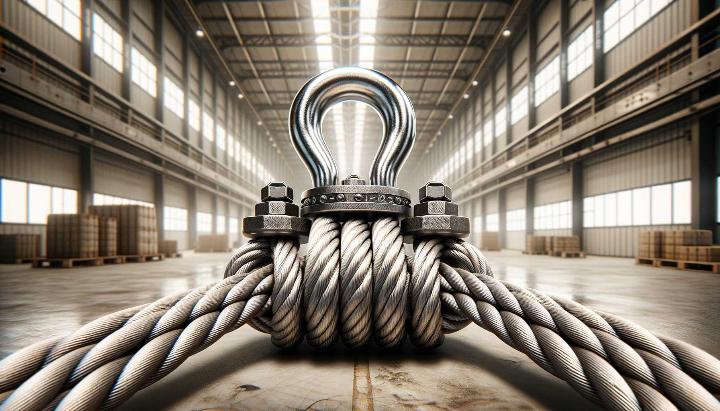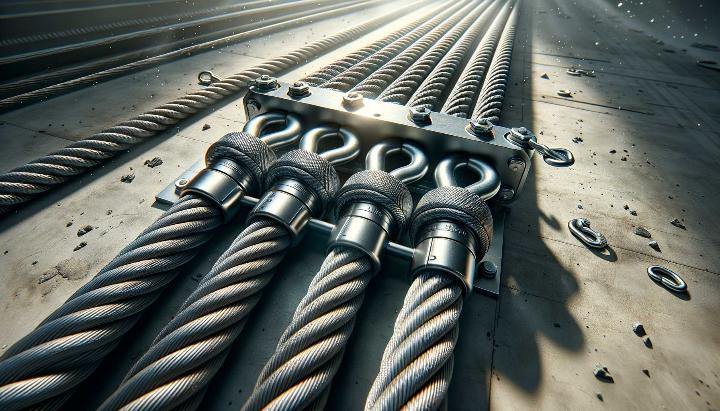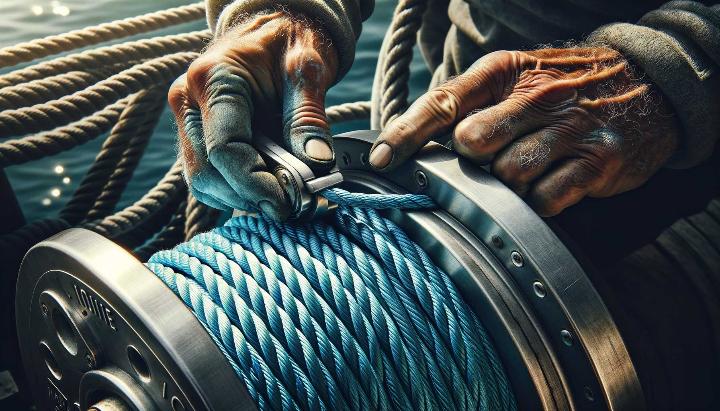Picture this: a colossal piece of machinery suspended in mid-air, perfectly balanced and secure. What's the secret behind such a feat? Enter the unsung hero of industrial lifting: the four leg wire rope sling. These marvels of engineering are revolutionising the way we handle heavy loads, and they're about to change the game for your business too.
At iRopes, we've taken the four leg wire rope sling to new heights by introducing our innovative 12-strand UHMWPE rope construction. This game-changing design offers unparalleled strength-to-weight ratios, making even the most challenging lifts seem effortless. But why should you care about this leap in lifting technology?
In this post, we'll dive deep into the world of four leg wire rope slings, exploring their unique advantages, from enhanced load distribution to versatile applications across industries. We'll also uncover the secrets of selecting the perfect sling for your needs and reveal how our custom solutions, including the cutting-edge 12-strand UHMWPE rope, can elevate your operations to new heights of efficiency and safety.
Whether you're in construction, shipping, or any industry that demands reliable heavy lifting, understanding the power of four leg wire rope slings is crucial. So, buckle up as we embark on a journey to discover how these durable solutions can transform your lifting game and give your business the competitive edge it deserves.
Understanding Four Leg Wire Rope Slings
Have you ever wondered how massive loads are lifted and moved with such precision in construction sites or industrial facilities? Let me introduce you to the unsung heroes of the lifting world: four leg wire rope slings. These robust lifting devices are the backbone of many heavy-duty operations, and understanding their intricacies can be fascinating.
Components and Design of Four Leg Wire Rope Slings
Picture a sturdy metal ring at the center, known as the master link. From this central point, four wire rope legs extend outward, each terminating with an end fitting such as a hook or shackle. This design isn't just for show - it's a masterpiece of engineering that allows for superior load distribution and stability.

The wire rope legs are the workhorses of the sling. They're typically made from high-strength steel wires twisted together to form a durable and flexible rope. The master link acts as the central connection point, distributing the load evenly across all four legs. End fittings are crucial for attaching the sling to both the load and the lifting device.
Applications and Advantages of Four Leg Slings
From my experience on construction sites, I've seen four leg wire rope slings tackle an impressive array of lifting challenges. They're the go-to choice for lifting irregularly shaped or oversized loads that would be difficult to balance with simpler sling configurations.
- Superior load distribution: The four-leg design spreads the weight evenly, reducing stress on any single point.
- Enhanced stability: With four points of contact, loads are less likely to shift or rotate during lifting.
- Versatility: These slings can adapt to a wide range of load shapes and sizes.
- Increased safety: The redundancy provided by multiple legs adds an extra layer of security.
I once witnessed a four leg sling effortlessly lift a massive, asymmetrical piece of industrial equipment that had stumped other rigging attempts. It was a testament to the sling's versatility and load-balancing capabilities.
Capacity Calculation and Safety Considerations
Determining the correct capacity of a four leg wire rope sling is crucial for safe lifting operations. It's not as simple as multiplying the capacity of one leg by four - factors like the angle between the legs and the load's center of gravity play significant roles.
Always consult load charts and follow manufacturer guidelines when calculating sling capacity. Overloading can lead to catastrophic failures.
Remember, the strength of a four leg sling is only as good as its weakest component. Regular inspections are essential to ensure all parts are in top condition. Look for signs of wear, corrosion, or damage, especially around the master link and end fittings.
As we delve deeper into the world of four leg wire rope slings, you'll discover how these versatile tools are revolutionizing lifting operations across industries. Stay tuned as we explore their key features and benefits in the next section!
Key Features and Benefits of Four Leg Slings
Have you ever marvelled at how effortlessly massive loads are hoisted and manoeuvred on construction sites? The secret lies in the remarkable four leg wire rope slings. These unsung heroes of the lifting world are revolutionising heavy-duty operations across industries. Let's dive into what makes these slings so special and why they're becoming the go-to choice for lifting professionals.
Understanding Four Leg Sling Design
Picture a robust metal master link at the centre, from which four sturdy wire rope legs extend outward like a spider's web. Each leg terminates with a hook or shackle, creating a design that's not just visually impressive but also a marvel of engineering.

The wire rope legs, typically crafted from high-strength steel, are the workhorses of the sling. They're designed to be both durable and flexible, capable of withstanding immense loads while adapting to various shapes. Some advanced designs even incorporate 12 strands of UHMWPE rope, offering an exceptional strength-to-weight ratio.
Advantages of Using Four Leg Slings
The benefits of four leg slings are numerous, making them indispensable in rigging operations:
- Unparalleled load distribution: The four-leg design spreads the weight evenly, significantly reducing stress on any single point.
- Enhanced stability: With four points of contact, loads are far less likely to shift or rotate during lifting, providing a level of control that's hard to match.
- Versatility in lifting: These slings adapt effortlessly to a wide range of load shapes and sizes, from bulky machinery to irregularly shaped components.
- Increased safety factor: The redundancy provided by multiple legs adds an extra layer of security, crucial in high-stakes lifting operations.
Applications and Load Capacity
Four leg wire rope slings shine in various industries, from construction and manufacturing to shipping and offshore operations. I've personally witnessed these slings in action at a shipyard, effortlessly lifting a 50-ton engine block into place with pinpoint accuracy.
When it comes to load capacity, these slings are true powerhouses. Depending on the design and materials used, they can safely handle loads up to 100 tons or more. However, it's crucial to remember that load capacity isn't just about the sling's strength.
Always consult load charts and factor in the angle of the sling legs when calculating safe working loads. The wider the angle, the lower the lifting capacity.
For those with specific lifting requirements, many manufacturers offer customisation options. Adjustable legs, for instance, provide flexibility for loads with off-centre centres of gravity. And for applications demanding the utmost in strength and lightness, slings featuring 12 strands of UHMWPE rope are pushing the boundaries of what's possible in lifting technology.
As we continue to explore the world of four leg wire rope slings, you'll discover how these versatile tools are not just lifting loads, but elevating entire industries. Stay tuned as we delve into selecting the right sling for your needs in our next section!
Selecting the Right Four Leg Wire Rope Sling
Choosing the perfect four leg wire rope sling for your lifting needs can feel like navigating a maze. But fear not! I'm here to guide you through the process, drawing from years of experience in the rigging industry. Let's dive into the key factors that will ensure you select a sling that's not just adequate, but exceptional for your specific requirements.
Key Characteristics of Four Leg Wire Rope Slings
Four leg wire rope slings are marvels of engineering, designed to distribute loads evenly and provide unparalleled stability. Picture a sturdy master link at the centre, with four robust legs radiating outwards, each terminating in a hook or shackle. This configuration offers several advantages over other sling types:
- Superior load distribution: The four-leg design spreads the weight across multiple points, reducing stress on any single area.
- Enhanced stability: With four points of contact, loads are less likely to shift or rotate during lifting.
- Versatility: These slings can handle a wide range of load shapes and sizes, making them ideal for various industries.
One crucial aspect to consider is the sling leg angle. I once witnessed a near-miss on a construction site where an inexperienced rigger used a four leg sling with too wide an angle, significantly reducing its lifting capacity. Remember, the ideal angle between sling legs and the vertical is 45 to 60 degrees. As the angle increases, the sling's capacity decreases dramatically.

Determining Weight Capacity and Load Requirements
Calculating the proper capacity for your four leg wire rope sling is crucial for safe and efficient lifting operations. Here's a step-by-step guide to help you determine the right size:
- Determine the weight of your load
- Calculate the Working Load Limit (WLL) needed for your application
- Use the formula: Safe Working Load (SWL) = 2.1 x WLL of a single sling leg
- Factor in the sling angle using a sling angle capacity chart
- Choose a sling with a capacity that exceeds your calculated requirements
Let's break this down with a practical example. Imagine you need to lift a 10-ton piece of machinery. You've determined that a 45-degree sling angle will work best for your setup. Using the formula above, you'd calculate:
SWL = 10 tons / (2.1 x 0.7071) = 6.7 tons per leg
Note: 0.7071 is the sling angle factor for a 45-degree angle
In this case, you'd need a four leg wire rope sling with a minimum capacity of 6.7 tons per leg. Always round up and choose a sling with a higher capacity to ensure a safety margin. For more insights into maximizing rope strength, you can refer to our guide on nylon and wire ropes.
Choosing the Proper Construction and End Fittings
When selecting your four leg wire rope sling, consider the following factors:
- Wire rope construction: Look for ropes with high strength, fatigue resistance, and crush resistance. For demanding applications, consider slings featuring 12 strands of UHMWPE rope, known for their exceptional strength-to-weight ratio.
- End fittings: Choose fittings that are compatible with your lifting equipment and suitable for your specific application. Options include hooks, shackles, and master links.
- Environmental conditions: Consider factors like temperature, exposure to chemicals, and potential for abrasion when selecting your sling materials.
Remember, the right four leg wire rope sling is an investment in safety and efficiency. By carefully considering these factors and consulting with reputable manufacturers like iRopes, you'll be well-equipped to choose a sling that meets and exceeds your lifting requirements.
Proper Use and Maintenance of Four Wheeler Winch Rope
When it comes to off-road adventures, your four wheeler winch rope is your trusty sidekick. But like any good companion, it needs proper care to perform at its best. Let's dive into the nitty-gritty of keeping your winch rope in top shape, ensuring it's ready for action when you need it most.
Cleaning and Inspecting Your ATV Winch Rope
After a muddy trail ride or a dusty desert trek, your winch rope deserves some TLC. Here's how to give it a proper clean:
- Unspool the rope completely and lay it out straight.
- Use a mild soap and water solution to gently clean the rope.
- Rinse thoroughly with clean water to remove all soap residue.
- Allow the rope to air dry completely before respooling.
While cleaning, keep your eyes peeled for any signs of wear and tear. Look out for:
- Fraying: Small broken fibres can quickly turn into bigger problems.
- Kinks: These weak points can compromise your rope's strength.
- Abrasions: Rough spots that could indicate internal damage.
If you spot any significant damage, it's time to replace your winch rope. Don't risk your safety with a compromised line!
Lubricating and Respooling Synthetic Winch Cable
Proper lubrication can double your winch rope's service life. Here's how to do it right:
- Choose a lubricant specifically designed for synthetic ropes.
- Apply a thin, even coat along the entire length of the rope.
- Work the lubricant into the fibres with a clean cloth.
Now, let's talk respooling. This step is crucial for maintaining your winch's performance:
- Attach the rope to the winch drum securely.
- Apply moderate tension to the rope as you spool it back onto the drum.
- Guide the rope evenly across the drum, avoiding bunching or overlapping.

Remember, a properly maintained winch rope isn't just about performance—it's about safety. By following these steps, you're not only extending the life of your equipment but also ensuring it's ready to pull you out of a tight spot when you need it most.
As a rule of thumb, consider replacing your synthetic winch line every five years, even if it appears to be in good condition. The elements can take their toll over time, and it's better to be safe than sorry when you're out on the trails. Explore our recommendations for synthetic winch ropes to find suitable replacements that offer superior safety and performance.
By incorporating these maintenance practices into your regular ATV care routine, you'll ensure your four wheeler winch rope is always ready for your next off-road adventure. Happy trailing, and may your winch always be up to the task!
```htmlFour leg wire rope slings are revolutionising heavy lifting across industries due to their enhanced load distribution, stability, and compliance with safety standards. Constructed with high-strength steel and sometimes featuring 12 strands of UHMWPE rope, these devices offer durability and versatility for handling oversized or irregular loads. When selecting a four leg sling, factors such as load capacity and angle are crucial for optimal performance. Regular maintenance ensures longevity, with practices applicable even for your four wheeler winch rope. iRopes provides customised solutions to meet specific lifting needs, aligning with stringent safety and compliance standards.
Explore Customised Four Leg Wire Rope Sling Solutions
Above is a form to help you connect with us for tailored solutions and further assistance. Our experts at iRopes are ready to help you select the right four leg sling to elevate your projects and ensure safety in your lifting operations. Feel free to reach out for guidance and explore our customised offerings.
```